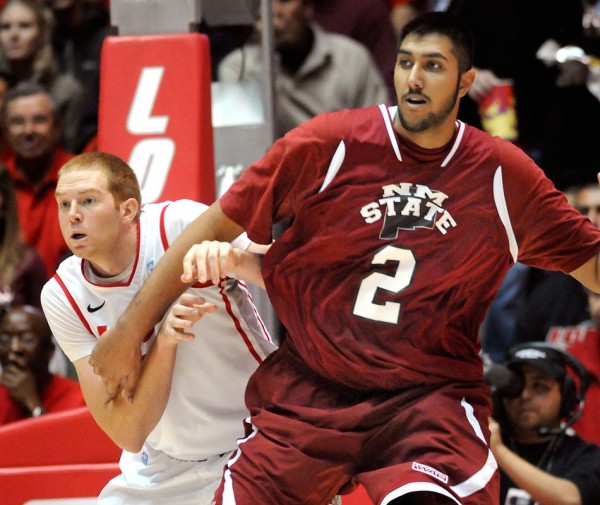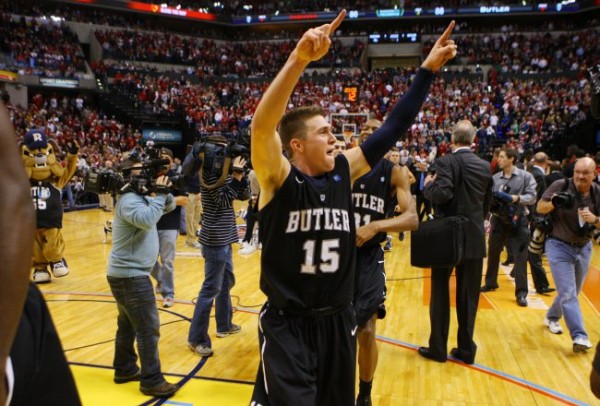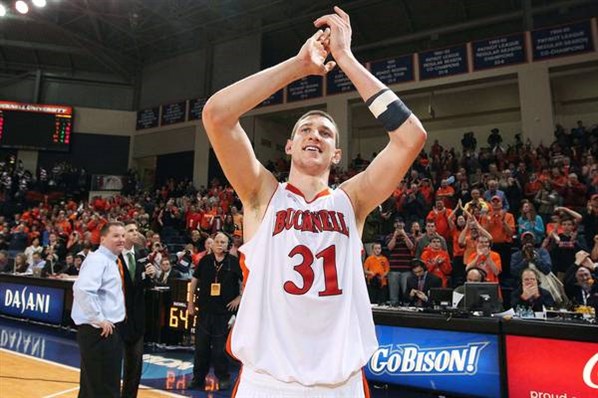The Other 26: Bracket-Busting, East and Midwest Edition
Posted by IRenko on March 20th, 2013I. Renko is an RTC columnist and the author of the weekly column, The Other 26. Follow him on Twitter @IRenkoHoops.
This is part two of our TO26 bracket analysis, focusing on the 17 non-power-conference teams that populate the East and Midwest regions. The teams are grouped into five rough categories, and, within each category, they are ordered by their likelihood of advancing. For our analysis of the South and West regions, see here.
Regional Threats
These are the teams that have a credible chance of dancing all the way to the Sweet Sixteen and beyond.
- St. Louis (#4 Midwest) — The Bilikens are flying a bit under the radar, but this is a team that should be a favorite for a Sweet 16 run. They have one of the best defenses in the country, a group of experienced guards who can attack and shoot (Kwamain Mitchell, Mike McCall, Jordair Jett), a surprisingly effective post presence in Dwayne Evans, and a pair of pick-‘n-pop big men (Rob Loe, Cody Ellis) who can drain the three. It should be said, though, that the Bilikens’ draw is not necessarily ideal. A first-round game against New Mexico State presents some matchup quandaries (see below), as does a potential Third Round game against Oklahoma State — both teams are prepared to bang and grind with the Bilikens down low. Ultimately, I think the St. Louis’ defense is strong enough to get them to the Sweet 16, where their steady guard play gives them a non-trivial chance of knocking off the Cards.
- Butler (#6, East) — Yes, they’re back. Neither Bucknell nor their potential Third Round opponent (Marquette or Davidson) will be an easy team to conquer, but all three of these teams will give Butler an important reprieve from its biggest vulnerability — a tendency to turn it over. Bucknell and Marquette will also play at the kind of grinding pace at which the Bulldogs excel. And they’ll focus their offense on the areas of the floor where Butler’s defense is strongest — the paint. Butler also has the shooters — Rotnei Clark, Kellen Dunham — to bombard Marquette’s compact defense and the rebounders to exploit Marquette’s weakness on the glass. If anything, Bucknell may pose a bigger matchup problem, as they tend to chase teams off the three-point line and they don’t give up much on the offensive glass. The Bison will be a tough opponent, but when you look at Butler’s pod as a whole, a Sweet 16 run looks well within reach.
One and Done
These teams have at least a 50/50 (or better) chance of picking up a win, but are unlikely to get two.
- Colorado State (#8, Midwest) — I would actually bump the Rams up to the tail end of the “Regional Threats” group if not for the uncertain status of starting point guard Dorian Green. The team’s unquestioned floor general, Green suffered an ankle injury in the first round of the MWC tournament, and though he played in a semifinal loss to UNLV, was ineffective. With a fully healthy Green, the Rams’ have a good chance of toppling Missouri. The two teams are somewhat similar in that they try to score in the paint on offense, while keeping opponents out of the paint of it on defense. Neither team is especially potent from the three-point line, and both rely a fair amount on offensive rebounding, though the Rams’ have the advantage here, especially as they are equally adept at controlling their defensive glass. That, along with Missouri’s tendency to be a bit loose with the ball, may be the difference-maker. And don’t sleep on Colorado State’s chances against Louisville in the next round. The Cardinals’ weak points are defensive rebounding and three-point shooting. The Rams are the best offensive rebounding team in the country, and as noted above, their defense forces teams to beat them from the three-point line. They also take pretty good care of the ball, which will serve them well against Louisville’s pressure defense. But this analysis could be all for naught if Green isn’t healthy enough to be effective.
- Creighton (#7, Midwest) — Doug McDermott is perhaps the most fundamentally sound player in college basketball. His All-American status owes itself to his incredibly precise offensive footwork, positioning, movement, shot, and cuts. He has inside-outside skills that present a very tough matchup if you’re not used to guarding him. And he’s surrounded by lots of great three-point shooters. Cincinnati’s defense has generally been strong, so they might be able to contain McDermott and the Bluejays’ three-point attack. But they’ll have to be especially effective because their offense has been truly miserable. I like the Bluejays’ chances here. A Third Round matchup with Duke would be a tougher proposition, as the Blue Devils combine a defense that shuts down the three-point line with an offense that is far more high-powered than Cincinnati’s. McDermott may well get his points, especially posting up inside, but that’s not likely to be sufficient.
- UNLV (#5, East) — The Runnin Rebels have a 7-2 mark over the last nine games, but I am skeptical of their ability to harness their talent and win away from home. Of course, it’s important to note that their best road victory this year was at Cal, their Second Round opponent (a scheduling quirk that the NCAA Selection Committee said was unavoidable). UNLV won that game by just a point on the strength of 27 points from Anthony Bennett and a considerable rebounding advantage. I expect them to have a strong edge on the glass again, one of many facts that makes this a generally good matchup for UNLV. Cal also does not have the kind of defense that can exploit UNLV’s looseness with the ball, and its poor three-point shooting will force it to conquer the impressive inside presence of Bennett and Khem Birch. But despite the matchup, UNLV is so unreliable that an upset wouldn’t surprise me. And if the Runnin Rebels do advance, Syracuse’s stout zone defense and ability to force turnovers will likely do them in.
- Memphis (#6, Midwest) — After a season in which they dominated their C-USA competition but failed to notch any noteworthy wins, Memphis comes into the Tournament with a lot to prove. Against St. Mary’s on Thursday, they will face a team with the potential to slow them down and force them to play at the kind of pace they struggle with. They’ll also face a strong rebounding team that could keep them from getting easy buckets off the offensive glass. The good news for Memphis is that their defense, especially at the rim, has been solid, and they’ve been hitting their threes. When an offense loses its rhythm, as Memphis’ does from time to time, the ability to knock down a jumpshot is crucial. It also helps that the Gaels don’t apply a lot of defensive pressure, as ball control is a weak spot for the Tigers. But an upset is a real possibility, especially given Memphis’ somewhat underachieving tendency in the past few years. If the Tigers do prevail, they’ll face a Michigan State team that will pose them with the same challenge — a more grinding pace, fewer chances on the glass, and a tough interior defense.
The Slipper May Fit
These are the low seeds that have a solid chance of scoring a Second Round upset.
- St. Mary’s (#11, Midwest) — Maybe it wouldn’t even qualify as an upset for St. Mary’s to knock off Memphis. The Gaels proved their mettle on Tuesday night against a Middle Tennessee squad that brings the kind of physicality they can expect from the Tigers. With Matthew Dellavedova rediscovering his shooting form this week, he will be difficult for Memphis to contain. Defensively, the Gaels also demonstrated on Tuesday their ability to stop transition buckets, contain the dribble drive, and clog up the paint, all of which will be key to stopping Memphis.
- Bucknell (#11, East) — Many were surprised that Bucknell got as high as an 11 seed, but the Bison are no slouches. They have the most valuable postseason commodity of all — a genuine star who can carry the team in Mike Muscala. Muscala is a force at both ends of the court, scoring in multiple ways, rebounding the ball like a vacuum, and protecting the rim from would-be scorers. As noted above, Bucknell is strong enough defensively to keep Butler off the glass, chase them off the three-point line, and clamp down on them inside. But offensively, Butler has its own tough interior defense which could be tough for Muscala and his frontcourt mate Joe Willman to overcome. This game may well come down to just how heavy a burden Muscala can carry on the offensive end against a physical, tough Butler defense.
- Davidson (#14, East) — I’m probably not as excited about Davidson’s upset potential as many, but they certainly have a decent chance. That’s mostly attributable to the fact that Marquette likes to take away shots at the rim, but they let you shoot, and Davidson won’t hesitate. The Wildcats take a lot of threes, and they make a healthy number. Forwards Jake Cohen and De’Mon Brooks are inside-out big men of the sort that is not terribly common in the Big East and could pose some matchup difficulties for Marquette’s frontcourt. The rub is whether Davidson will be able to contain Marquette’s paint-oriented offensive attack. Marquette’s physical strength and mid-range offense could pose trouble for the Wildcats, especially as they can be foul-prone. At home against a Montana team with a somewhat similar style of play, Davidson gave up 1.19 points per possession and a 55.3 percent two-point field goal percentage. They were pushed to overtime before finally prevailing on the strength of their own offensive output. This is a doable upset, but Marquette is a better team than Montana, and Davidson will have to find a way to contain their offense.
- Valparaiso (#14, Midwest) — When you’re a team that takes and makes a lot of threes, you always have a chance at pulling an upset. Valpo has three shooters with over 40 made threes and at least a 39 percent three-point shooting percentage. Foremost among them is their star swing forward, Ryan Broekhoff, a fearless scorer who can go inside and out and has the ability to carry a team offensively. The Crusaders also do a nice job on the defensive glass, which is always important against a Tom Izzo team. Where they might struggle is containing Michigan State’s athleticism. Valpo tends to force teams off the three-point line, but that may not be the best strategy against a Spartans’ team that is prone to dry shooting spells but has the athletes to drive to the basket.
A Puncher’s Chance
These teams have an outside shot of winning their second round game — if lots of things break their way.
- Temple (#9, East) — I don’t think the relatively short Owls will be able to contain N.C. State’s athleticism across the front line. Scott Wood is a streaky shooter, but when he’s on, as he’s been recently, his three-point shooting adds an important dimension to the Wolfpack’s offense. At the other end, the Owls take a lot of threes, but this is one area where N.C. State’s defense excels, holding opponents to less than 30 percent shooting from the arc. The Owls could muster a win if Khalif Wyatt, on whom they’re so dependent, has a great game, and N.C. State remains a team of underachieving talent. But I think it’s much more likely than not that the Owls fall.

The Unconventional Game of New Mexico State’s Gentle Giant, Sim Bhullar, Gives New Mexico State an Outside Shot at an Upset (Jim Thompson/Albuquerque Journal)
- New Mexico State (#13, Midwest) — St. Louis has a very tough defense with a physical guard corps that is likely to harass NMSU’s turnover-prone guards into coughing up the rock. The Bilikens will also make it difficult for the Aggies to hit the offensive glass, as they like to do. But there are signs of hope for the Aggies. St. Louis’ tendency to deny the three-point shot won’t much affect the Aggies, who like to do their scoring inside. If they can pound the ball down low — off the dribble, or through 7-5, 360 pound freshman Sim Bhullar — they might be able to gain some traction and pick up some trips to the free throw line. Defensively, too, the Aggies could make things difficult for St. Louis, especially undersized post Dwayne Evans. Bhullar is an imposing obstacle on defense, but he is about as fleet-footed as his weight suggests he’d be. St. Louis’ big men love to pop out to the perimeter for jump shots, so unless the Aggies decide to play a zone, this could pose some problems for them. At the end of the day, St. Louis is likely to be too tough defensively and too mature and composed to let this game slip, but the Aggies have a shot.
- Pacific (#15, East) — This may be your best chance for a 2-15 upset. Miami has shown that they’re capable of losing to teams of Pacific’s quality, having dropped games to Florida Gulf Coast, Indiana State, Wake Forest, and Georgia Tech. Offensively, the Hurricanes spread the floor and try to beat you off the dribble, but the Tigers do a nice job of crowding the paint and forcing opponents to shoot threes. Miami also likes to push teams out to the three-point line, but Pacific shoots a better percentage from behind the arc — almost 40 percent. They have eight players who have made at least 20 threes, and all but one shoots over 38 percent from behind the arc. If Miami tries to extend on them, Pacific’s guards, led by point Lorenzo McCoud, won’t hesitate to drive and create. What could undo the Tigers’ upset bid, as it does to many a mid-major team, is their relative lack of size, particularly inside. Reggie Johnson’s girth, Kenny Kadji’s length, and Julian Gamble’s general size and strength could pose a very difficult challenge.
- Montana (#13, East) — The Grizzlies are getting a bit of love as a potential upset pick, but this is not a good matchup for them. Their backcourt of Kareem Jamar and Will Cherry like to attack the paint and get to the basket, but they will find it that a difficult task against a long and strong Syracuse zone. And with the loss of Mathias Ward to a season-ending injury, Montana lacks the size and strength to compete with Syracuse’s imposing frontcourt. They’re unlikely to exploit the Orange’s weakness on the defensive glass or to contain Syracuse’s strength on the offensive glass. And while Montana tends to keep teams off the three-point line, that will suit Syracuse just fine. The Grizzlies one shot in this game is to get hot from outside, raining threes from secondary players like Jordan Gregory, Mike Weisner, and Spencer Coleman.
Enjoy Your Parting Gift
- Albany (#15, Midwest) — The best way to attack Duke’s defense is to get into its guts and score in the paint. But a team like Albany — with a relatively high turnover rate, and a heavy reliance on free throw shooting and three-point shots — does not have the kind of approach that is conducive to that. There’s no C.J. McCollum on this team to withstand Duke’s perimeter pressure and break down the defense. And on the other end of the floor, Duke’s quickness and interior scoring ability will be tough to contain.
- North Carolina A&T (#16, Midwest) — The Aggies won the first NCAA Tournament game in school history on Tuesday night with a surprisingly effective shooting performance. But it’s one thing to manage such a feat against a Liberty defense ranked outside the top 300 and another to pull it off against the best defense in the country. The Aggies may try to beat Louisville at its own game, with pressure defense, but don’t expect the Cards to wilt.
- Long Island / James Madison (#16, East) — Long Island’s defense is just too weak, especially inside, to stop Indiana. Their up-tempo offense, heavy on transition and dribble penetration, could give IU some trouble, but playing that pace against a high-octane team like the Hoosiers is not the best way to beat them. James Madison could give IU a bit more trouble with its strength physicality, but they lack height inside and are foul-prone, two traits that make a matchup with the Zeller-led Hoosiers a tough one.












































